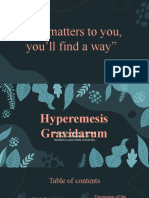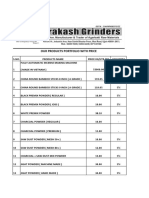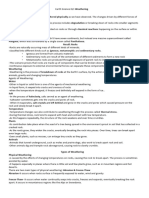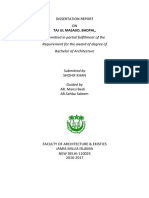0 ratings0% found this document useful (0 votes)
46 viewsChapter Two
Chapter Two
Uploaded by
Iris NguyễnThis document summarizes Chapter Two from the textbook "English Phonetics and Phonology: A Practical Course" by Peter Roach. It discusses the production of speech sounds, including the vocal tract, larynx, articulators (parts of the vocal tract involved in sound production), and describes the specific articulators - the pharynx, soft palate, hard palate, alveolar ridge, tongue, teeth, and lips. It also defines vowels sounds as voiced sounds without obstruction, and consonant sounds as those with obstruction, and lists the six short English vowel sounds.
Copyright:
© All Rights Reserved
Available Formats
Download as PDF, TXT or read online from Scribd
Chapter Two
Chapter Two
Uploaded by
Iris Nguyễn0 ratings0% found this document useful (0 votes)
46 views4 pagesThis document summarizes Chapter Two from the textbook "English Phonetics and Phonology: A Practical Course" by Peter Roach. It discusses the production of speech sounds, including the vocal tract, larynx, articulators (parts of the vocal tract involved in sound production), and describes the specific articulators - the pharynx, soft palate, hard palate, alveolar ridge, tongue, teeth, and lips. It also defines vowels sounds as voiced sounds without obstruction, and consonant sounds as those with obstruction, and lists the six short English vowel sounds.
Original Title
ChapterTwo
Copyright
© © All Rights Reserved
Available Formats
PDF, TXT or read online from Scribd
Share this document
Did you find this document useful?
Is this content inappropriate?
This document summarizes Chapter Two from the textbook "English Phonetics and Phonology: A Practical Course" by Peter Roach. It discusses the production of speech sounds, including the vocal tract, larynx, articulators (parts of the vocal tract involved in sound production), and describes the specific articulators - the pharynx, soft palate, hard palate, alveolar ridge, tongue, teeth, and lips. It also defines vowels sounds as voiced sounds without obstruction, and consonant sounds as those with obstruction, and lists the six short English vowel sounds.
Copyright:
© All Rights Reserved
Available Formats
Download as PDF, TXT or read online from Scribd
Download as pdf or txt
0 ratings0% found this document useful (0 votes)
46 views4 pagesChapter Two
Chapter Two
Uploaded by
Iris NguyễnThis document summarizes Chapter Two from the textbook "English Phonetics and Phonology: A Practical Course" by Peter Roach. It discusses the production of speech sounds, including the vocal tract, larynx, articulators (parts of the vocal tract involved in sound production), and describes the specific articulators - the pharynx, soft palate, hard palate, alveolar ridge, tongue, teeth, and lips. It also defines vowels sounds as voiced sounds without obstruction, and consonant sounds as those with obstruction, and lists the six short English vowel sounds.
Copyright:
© All Rights Reserved
Available Formats
Download as PDF, TXT or read online from Scribd
Download as pdf or txt
You are on page 1of 4
See discussions, stats, and author profiles for this publication at: https://www.researchgate.
net/publication/356423963
English Phonetics and Phonology, Chapter Two: The Production of Speech
Sounds.
Presentation · November 2021
DOI: 10.13140/RG.2.2.12148.68484
CITATIONS READS
0 2,092
1 author:
Sara Alaa Jasim Zahid
Al-Mansour University College
11 PUBLICATIONS 0 CITATIONS
SEE PROFILE
Some of the authors of this publication are also working on these related projects:
Summarizing course-books. View project
TOEFL iBT View project
All content following this page was uploaded by Sara Alaa Jasim Zahid on 21 November 2021.
The user has requested enhancement of the downloaded file.
English Phonetics and Phonology: A Practical Course
Peter Roach, 14th Edition
Second-year Classes
Asst. Lec. Sara Alaa
Chapter Two
The Production of Speech Sounds
Q 1. How speech sounds (phonemes) are produced?
-The muscles in the chest produce the flow of air that is needed for all speech sounds.
The air passes through the larynx, and goes through the vocal tract, which ends at the
mouth (the oral cavity) and the nostrils (the nasal cavity). Here the air from the lungs
escapes into the atmosphere.
Q 2. What is meant by ‘articulators’?
-Articulators are different parts of the vocal tract, these parts are necessary in sounds
production.
Q 3. What are the articulators above the larynx?
-There are seven articulators above the larynx, these are: the pharynx, the soft palate,
the hard palate, the alveolar ridge, the tongue, the teeth and the lips.
Q 4. Define ‘the pharynx’
-The pharynx is a tube which begins just above the larynx. It is about 7 cm long in
women and about 8 cm in men; it divides into two ends, one part being the back of the
oral cavity and the other being the beginning of the nasal cavity.
Q 5. Define ‘the soft palate (velum)’
-The soft palate (velum) is the part that allows air to pass through the nose and through
the mouth, it is one of the articulators that can be touched by the tongue. Sounds like
/k, g/ are produced when the tongue is in contact with the lower side of the soft palate,
and they are called velar consonants.
Q 6. Define ‘the hard palate’
-The hard palate is often called the ‘roof of the mouth’. It has a curved surface. A
consonant made with the tongue close to the hard palate is called palatal. The sound /j/
in ‘yes’ is palatal.
Q 7. Define ‘the alveolar ridge’
-The alveolar ridge is placed between the top front teeth and the hard palate. Its surface
is rough and covered with little ridges. Sounds made with the tongue touching this part
like: /t, d, n/ are called alveolar.
Q 8. Define ‘the tongue’ What are its parts?
-The tongue is a very important articulator because it moves into many different places
and different shapes. The parts of the tongue are: tip, blade, front, back and root.
Q 9. Define ‘the teeth’
-The teeth (upper and lower teeth). Sounds made with the tongue touching the front
teeth, like: /θ, ð/ are called dental.
Q 10. Define ‘the lips’
-The lips are important in speech. They can be pressed together in sounds like: /p, b/
are called bilabial, or brought into contact with the teeth in sounds like: /f, v/ are called
labiodental, or rounded to produce the lip-shape for vowels like /u:/.
Q 11. What is meant by ‘vowel sounds’?
-Vowel sounds are set of voiced sounds in which there is no obstruction to the flow of
air as it passes from the larynx to the lips.
Q 12. What is meant by ‘consonant sounds’?
-Consonant sounds are set of sounds in which there is an obstruction to airflow as it
passes from the larynx to the lips.
Q 13. How many English sort vowels are there?
-There are six English short vowels: /ɪ, e, æ, ʌ, ʊ, ɒ/.
/ɪ/ as in bit, pin, fish.
/e/ as in bet, men, yes.
/æ/ as in bat, man, gas.
/ʌ/ as in cut, come, rush.
/ɒ/ as in pot, gone, cross.
/ʊ/ as in put, pull, push.
---------------------------------------------------------------------------------------------------------
View publication stats
You might also like
- Mandaluyong Fire and Flood Disaster PlansDocument8 pagesMandaluyong Fire and Flood Disaster PlansAura SorianoNo ratings yet
- Lecture One: Introduction To The Course of SemanticsDocument14 pagesLecture One: Introduction To The Course of SemanticsJana WaelNo ratings yet
- AMANIRENAS THE KANDAK OF KUSH: The Warrior Queen Who Took On The Romans and Won.Document19 pagesAMANIRENAS THE KANDAK OF KUSH: The Warrior Queen Who Took On The Romans and Won.toypom100% (1)
- Language HistoryDocument38 pagesLanguage Historysayed shahabuddin AdeebNo ratings yet
- Are You in The Right Place?Document164 pagesAre You in The Right Place?galuh pfNo ratings yet
- Chapter 9Document34 pagesChapter 9Salwa abNo ratings yet
- An Introductory English Grammar - Chapter 9Document13 pagesAn Introductory English Grammar - Chapter 9Dr.Eman LinguisticsNo ratings yet
- First Language AcquisitionDocument32 pagesFirst Language AcquisitionNadia SimónNo ratings yet
- اللغة الانكليزية تحليلات 2Document88 pagesاللغة الانكليزية تحليلات 2ss0857003No ratings yet
- CBSE Class 3 English Pronouns MCQS, Multiple Choice QuestionsDocument10 pagesCBSE Class 3 English Pronouns MCQS, Multiple Choice Questionsmangala kalaiselviNo ratings yet
- 904 Conditionals and Wish Clauses Advanced Level Mcqs Test With Answers 3Document5 pages904 Conditionals and Wish Clauses Advanced Level Mcqs Test With Answers 3sohailfaisal2006No ratings yet
- مراجعة لغة انجليزية - 2 ع - مارس - ذاكروليDocument80 pagesمراجعة لغة انجليزية - 2 ع - مارس - ذاكروليMahmood GbrNo ratings yet
- Chapter 15 Gestures and Sign Languages: The Study of Language, 5 Edition George YuleDocument8 pagesChapter 15 Gestures and Sign Languages: The Study of Language, 5 Edition George Yulesovanrat KhievNo ratings yet
- Soft ComputingDocument17 pagesSoft Computingnupurbopche633No ratings yet
- Language and The BrainDocument14 pagesLanguage and The BrainSherko YousifNo ratings yet
- Chapter 7 GrammarDocument29 pagesChapter 7 Grammarواثق جليل عودة حماديNo ratings yet
- Relative PronounsDocument2 pagesRelative Pronounsvanesa alarcon sanchezNo ratings yet
- Conjunctions and But 13928Document2 pagesConjunctions and But 13928applesecretgurlzNo ratings yet
- Summary About The Study of Language CH 12&13&14Document14 pagesSummary About The Study of Language CH 12&13&14somamohamed arafaNo ratings yet
- The Study of LanguageDocument26 pagesThe Study of LanguageGladyz Artjane Quilab Flores - CastilloNo ratings yet
- Week 5 Word FormationDocument22 pagesWeek 5 Word Formationsal AFNo ratings yet
- First Language AcquisitionDocument21 pagesFirst Language AcquisitionKeith Wheeler100% (1)
- Prepositions MCQsDocument11 pagesPrepositions MCQsخیال تارانNo ratings yet
- Linguistic Review SyntaxDocument3 pagesLinguistic Review SyntaxJoanneNo ratings yet
- Parts of SpeechDocument12 pagesParts of SpeechKh adijaNo ratings yet
- Phonetics (First Year English) Guerfi HindDocument28 pagesPhonetics (First Year English) Guerfi HindAlla L'GameurNo ratings yet
- The Process of Developing AssessmentDocument8 pagesThe Process of Developing AssessmentthechaltonatorNo ratings yet
- Assessing SpeakingDocument36 pagesAssessing SpeakingOni setiawan ParanginanginNo ratings yet
- Morphology and Syntax SyllabusDocument3 pagesMorphology and Syntax SyllabussulisNo ratings yet
- LI2BE Lecture 5 Intonation (COVID Version)Document42 pagesLI2BE Lecture 5 Intonation (COVID Version)Bára LidováNo ratings yet
- Sound Assimilation in English and Arabic A Contrastive Study PDFDocument12 pagesSound Assimilation in English and Arabic A Contrastive Study PDFTaha TmaNo ratings yet
- Basic ExamDocument17 pagesBasic ExamLidiaMinervaPérezBelmont100% (1)
- ConstituentsDocument3 pagesConstituentsemabenNo ratings yet
- Written Report in Introduction To Linguistic: Saint Michael College, Hindang LeyteDocument7 pagesWritten Report in Introduction To Linguistic: Saint Michael College, Hindang LeyteKyndi MadrazoNo ratings yet
- Linguistics 22 23Document5 pagesLinguistics 22 23mustafa khalidNo ratings yet
- A. Definition of X-Bar Theory: B. The Syntax AssemblyDocument9 pagesA. Definition of X-Bar Theory: B. The Syntax AssemblyMeggie UllyahNo ratings yet
- 896 - Adjective Relative Clauses Advanced Level Mcqs Test With Answers 1Document10 pages896 - Adjective Relative Clauses Advanced Level Mcqs Test With Answers 1Nutsuda AntreeNo ratings yet
- Chapter 9 (Semantics)Document42 pagesChapter 9 (Semantics)nooraNo ratings yet
- Tenses Active Passive: Assive Oice AbleDocument2 pagesTenses Active Passive: Assive Oice AbleGgpo Ggpo2No ratings yet
- Phonetic ProcessesDocument9 pagesPhonetic ProcessesSorayaHermawan75% (4)
- Reference and Meaning: Different RelatedDocument15 pagesReference and Meaning: Different RelatedIts VirgoNo ratings yet
- Aspects of Connected SpeechDocument7 pagesAspects of Connected SpeechJolyn LongNo ratings yet
- Do and Make Explanation and ExercisesDocument6 pagesDo and Make Explanation and ExercisesWulkymxNo ratings yet
- Morphological Structure of A Word. Word-Formation in Modern English 1. Give The Definition of The MorphemeDocument22 pagesMorphological Structure of A Word. Word-Formation in Modern English 1. Give The Definition of The MorphemeIvan BodnariukNo ratings yet
- Phonetic and PhonologyDocument57 pagesPhonetic and PhonologyjimmyNo ratings yet
- 1st. Lecture Introduction - What Is LanguageDocument30 pages1st. Lecture Introduction - What Is LanguageCik Puan AnneNo ratings yet
- Universitas Sumatera UtaraDocument13 pagesUniversitas Sumatera Utarahety hidayahNo ratings yet
- Choose The Correct OptionDocument23 pagesChoose The Correct OptionmmddNo ratings yet
- BASICS OF PsycholinguisticsDocument6 pagesBASICS OF Psycholinguisticshusnain.y4827No ratings yet
- Immediate Constituents: The Hierarchical Structure of WordsDocument4 pagesImmediate Constituents: The Hierarchical Structure of WordsRaghadNo ratings yet
- Complements Vs AdjunctsDocument7 pagesComplements Vs AdjunctsDanilo KrtolicaNo ratings yet
- Semantic and Syntactic InvestigationDocument87 pagesSemantic and Syntactic Investigationنور عبدالله100% (1)
- Syntax (Aspect of Deep Structure)Document19 pagesSyntax (Aspect of Deep Structure)Morin oktaviaNo ratings yet
- Vowel ArticulationDocument6 pagesVowel ArticulationMasrudin LasitamuNo ratings yet
- The Meaning of LanguageDocument53 pagesThe Meaning of LanguageReymark De GuzmanNo ratings yet
- Unit 1: Traffic Congestion: I. Key Words (1) Match The Following Words With Their Meanings On The RightDocument2 pagesUnit 1: Traffic Congestion: I. Key Words (1) Match The Following Words With Their Meanings On The RightLy Sing2No ratings yet
- 1.1 Phonetics - The Sounds of Language - Sounds SegmentsDocument16 pages1.1 Phonetics - The Sounds of Language - Sounds SegmentsJoel100% (1)
- Overview of English Linguistics CompilationDocument10 pagesOverview of English Linguistics CompilationIta Moralia RaharjoNo ratings yet
- Speech and Theater ExamDocument22 pagesSpeech and Theater ExamCres Jules ArdoNo ratings yet
- Speech Organs Produce The Many Sounds Needed For LanguageDocument7 pagesSpeech Organs Produce The Many Sounds Needed For LanguageSherwin Ryan AvilaNo ratings yet
- Bab I PendahuluanDocument9 pagesBab I PendahuluanEka MelyanaNo ratings yet
- Mixers: An Overview: BerkeleyDocument41 pagesMixers: An Overview: Berkeleymid_cycloneNo ratings yet
- Obligations and ContractsDocument30 pagesObligations and Contractsjonna timonanNo ratings yet
- Case Presentation Hyperemesis Gravidarum Maricar Abonado Midwifery IIDocument27 pagesCase Presentation Hyperemesis Gravidarum Maricar Abonado Midwifery IIMaricar Crescini AbonadoNo ratings yet
- New Mexico Game and Fish 2014 Hunting Rules and InfoDocument65 pagesNew Mexico Game and Fish 2014 Hunting Rules and InfoAmmoLand Shooting Sports NewsNo ratings yet
- Identity TheftDocument2 pagesIdentity TheftRamil dela CruzNo ratings yet
- Personalities in Institutional Corrections and Their Significant ContributionsDocument2 pagesPersonalities in Institutional Corrections and Their Significant ContributionsAngelica RacalNo ratings yet
- Price List 13.10.21Document3 pagesPrice List 13.10.21prince kumarNo ratings yet
- CC Unit 4, Cover Letters of OffersDocument20 pagesCC Unit 4, Cover Letters of OffersReikoAiNo ratings yet
- Battle of TrentonDocument6 pagesBattle of TrentonjpNo ratings yet
- Earth Science Q2 Weathering Internal Heat SourceDocument3 pagesEarth Science Q2 Weathering Internal Heat SourceJoan Vito CruzNo ratings yet
- Pharmacotherapy 10thDocument131 pagesPharmacotherapy 10thMuhamed Arsalan100% (3)
- CH 04Document32 pagesCH 04woyesoNo ratings yet
- Taj Ul Masajid BhopalDocument30 pagesTaj Ul Masajid BhopalMohd.Zeeshan shaikhNo ratings yet
- ISO Certificate For Shri Sai Baba Temple'Thane, MaharashtraDocument5 pagesISO Certificate For Shri Sai Baba Temple'Thane, MaharashtrarOhit beHaLNo ratings yet
- ALMIRA ResumeDocument3 pagesALMIRA ResumeJobelle Marquez AlmiraNo ratings yet
- Circular Motion - DPPs - (Only PDFDocument13 pagesCircular Motion - DPPs - (Only PDFmrityunjaibharti2502No ratings yet
- ScaffoldingDocument24 pagesScaffoldingAzrulZamriNo ratings yet
- 9lawrence Kohlberg's Theory of Moral DevelopmentDocument11 pages9lawrence Kohlberg's Theory of Moral DevelopmentMrinalini MinnyNo ratings yet
- Elegy NotesDocument5 pagesElegy NotesJimmi KhanNo ratings yet
- Land Titles and Deeds - Subsequent Registration - Sps Macadangdang V Sps MartinezDocument3 pagesLand Titles and Deeds - Subsequent Registration - Sps Macadangdang V Sps MartinezJosephine BrackenNo ratings yet
- November 2012 Ohio Board of Nursing NoticesDocument642 pagesNovember 2012 Ohio Board of Nursing NoticesJames LindonNo ratings yet
- Management Level Exam Blueprints 2022 2023 Version3Document60 pagesManagement Level Exam Blueprints 2022 2023 Version3KOHILAVANI A/P BALAN PREREG STUDENTNo ratings yet
- 260 Virgilio M. Cañete, Petitioner, vs. National Labor Relations Commission (Fourth Division) and Vicente TING/V.T. MARKETING, RespondentsDocument4 pages260 Virgilio M. Cañete, Petitioner, vs. National Labor Relations Commission (Fourth Division) and Vicente TING/V.T. MARKETING, RespondentsRaymarc Elizer AsuncionNo ratings yet
- Tourism's Three Main Impact AreasDocument7 pagesTourism's Three Main Impact AreasrepereuNo ratings yet
- Innovative Anti-Theft SystemDocument9 pagesInnovative Anti-Theft SystemnglbNo ratings yet
- HR KPIsDocument151 pagesHR KPIstaapNo ratings yet
- Hughes LawsuitDocument15 pagesHughes LawsuitKERANewsNo ratings yet
- Legal and Ethical Issue in Management Is An Important Aspect of Information Security in An OrganizationDocument4 pagesLegal and Ethical Issue in Management Is An Important Aspect of Information Security in An OrganizationPeter ThairuNo ratings yet

























































































